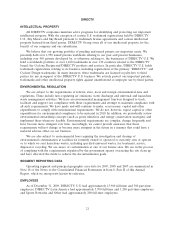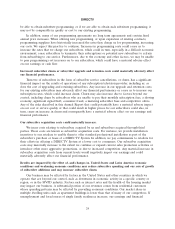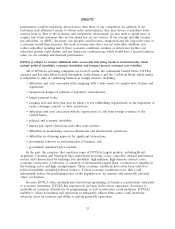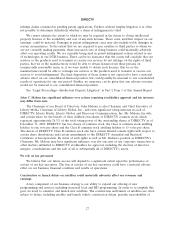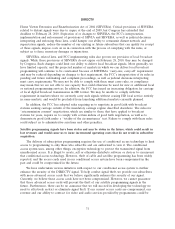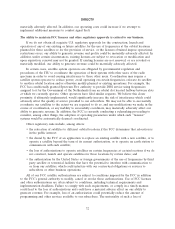DIRECTV 2009 Annual Report Download - page 38
Download and view the complete annual report
Please find page 38 of the 2009 DIRECTV annual report below. You can navigate through the pages in the report by either clicking on the pages listed below, or by using the keyword search tool below to find specific information within the annual report.DIRECTV
Our ability to keep pace with technological developments is uncertain.
In the video industry, changes occur rapidly as new technologies are developed, which could cause
our services and products that deliver our services to become obsolete. We may not be able to keep
pace with technological developments. If the new technologies on which we intend to focus our
investments fail to achieve acceptance in the marketplace or our technology does not work and requires
significant cost to replace or fix, we could suffer a material adverse effect on our future competitive
position, which could cause a reduction in our revenues and earnings. For example, our competitors
could be the first to obtain proprietary technologies that are perceived by the market as being superior.
Further, after incurring substantial costs, one or more of the technologies under development by us or
any of our strategic partners could become obsolete prior to its introduction.
In addition, technological innovation depends, to a significant extent, on the work of technically
skilled employees. Competition for the services of these employees has been vigorous. We cannot
assure you that we will be able to continue to attract and retain these employees.
To access technologies and provide products that are necessary for us to remain competitive,
particularly in the area of broadband services, we may make future acquisitions and investments and
may enter into strategic partnerships with other companies. Such investments may require a
commitment of significant capital and human and other resources. The value of such acquisitions,
investments and partnerships and the technology accessed may be highly speculative. Arrangements
with third parties can lead to contractual and other disputes and dependence on the development and
delivery of necessary technology on third parties that we may not be able to control or influence. These
relationships may commit us to technologies that are rendered obsolete by other developments or
preclude the pursuit of other technologies which may prove to be superior.
New technologies could also create new competitors for us. Entities such as telcos are supporting
digital video delivery over existing telephone lines and building out fiber optic lines to enhance their
capabilities to deliver programming services. Satellite operators such as SES have begun offering
turn-key packages of digital programming on a wholesale basis for distribution by rural telcos. In
addition, programming services offered over the Internet have become more prevalent as broadband
networks have improved their speed and quality of service. We may not be able to compete successfully
with new entrants in the market for video services.
Our business relies on intellectual property, some of which is owned by third parties, and we may
inadvertently infringe patents and proprietary rights of others.
Many entities, including some of our competitors, have or may in the future obtain patents and
other intellectual property rights that cover or affect products or services related to those that we
currently offer or may offer in the future. In general, if a court determines that one or more of our
services or the products used to transmit or receive our services infringes on intellectual property
owned by others, we and the applicable manufacturers or vendors may be required to cease developing
or marketing those services and products, to obtain licenses from the owners of the intellectual
property or to redesign those services and products in such a way as to avoid infringing the intellectual
property rights. If a third party holds intellectual property rights, it may not allow us or the applicable
manufacturers to use its intellectual property at any price, which could materially adversely affect our
competitive position.
We may not be aware of all intellectual property rights that our services or the products used to
transmit or receive our services may potentially infringe. In addition, patent applications in the United
States are confidential until the Patent and Trademark Office issues a patent. Therefore, we cannot
evaluate the extent to which our services or the products used to transmit or receive our services may
26







